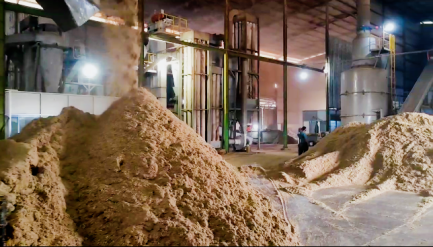Welcome to Rongda Machinery Co., Ltd
Toggle Navigation
Ever wondered what’s fueling the push for greener energy? Wood pellets might not be the first thing that pops into your mind, but they’re quietly becoming a big deal in the renewable energy world. These little compressed bits of wood are powering homes, industries, and even entire power plants. Let’s take a closer look at what’s driving the rise of wood pellet plants, how they work, and what’s next for this eco-friendly industry.
Picture this: tiny, cylindrical nuggets made from wood scraps like sawdust or wood chips. That’s a wood pellet. They’re a type of biomass fuel, meaning they come from organic materials, and they’re used mostly for heating or generating electricity. The cool part? They’re made from renewable resources, often sourced from responsibly managed forests, so they’re a solid choice for cutting down on fossil fuel use.
Turning wood into pellets isn’t as simple as squishing some sawdust together. It’s a process, and it’s kind of fascinating. First, logs get stripped of their bark and chopped into small chips. Those chips are then ground into a fine, powdery consistency and dried out to make them super durable. Finally, the powder gets pressed under intense heat and pressure to form those dense little pellets, which are cooled and sorted to ensure top quality. It’s like baking, but for energy!
A few big names are making waves in the wood pellet world:
Drax Group: This UK-based company is all about transforming old coal plants into wood pellet-powered ones, slashing carbon emissions in the process.
Enviva LLC: Over in the US, Enviva’s a heavy hitter, focusing on sustainable sourcing and churning out pellets like nobody’s business.
Pellet Fuel Europe (PFE): This European cooperative keeps quality high, making sure their pellets meet strict standards for markets across the continent.

So, why are wood pellets such a hot topic? For starters, they’re carbon-neutral, which means they don’t add extra greenhouse gases to the atmosphere when burned properly. That’s a huge win for fighting climate change. Plus, the industry creates jobs, boosts local economies, and helps countries rely less on imported fuels—hello, energy security!
But it’s not all smooth sailing. The demand for wood pellets is skyrocketing, which puts pressure on forests. Sustainable management is critical to avoid overharvesting. Then there’s the cost—making and shipping these pellets, especially overseas, can get pricey. And don’t get me started on regulations. Every region seems to have its own rules, making it a headache for producers to keep up.
Looking ahead, things are exciting. New tech is making pellet production more efficient and cheaper. Demand is growing, especially in places like Asia and South America, where renewable energy is catching on. The industry’s set to expand, and with it, new opportunities for innovation and growth.
What are wood pellets made from?
They’re crafted from compressed wood fibers, like sawdust or wood chips, usually from sustainably managed forests. Think of it as recycling wood waste into energy gold.
Why are people so into wood pellets?
They’re renewable, efficient, and produce way less carbon than coal or oil. Plus, they’re versatile—great for cozy home fireplaces or massive power plants.
How do you use wood pellets?
You can toss them into a pellet stove for home heating, use them in industrial boilers, or even power entire plants. They’re like the Swiss Army knife of renewable fuels.
Are they really good for the planet?
When sourced responsibly, yes! They’re carbon-neutral, meaning they don’t contribute to global warming the way fossil fuels do. But sustainable forestry is key.
Who’s making these pellets?
Big players like Drax Group, Enviva LLC, and Pellet Fuel Europe are leading the pack, each with their own spin on sustainable production.
Wood pellet plants are more than just a niche industry—they’re a key piece of the renewable energy puzzle. They offer a cleaner, homegrown alternative to fossil fuels, create jobs, and pave the way for a greener future. Sure, there are hurdles like sustainability and costs, but with new tech and growing markets, wood pellets are set to shine. So, next time you hear about renewable energy, don’t sleep on these little pellets—they’re small but mighty!